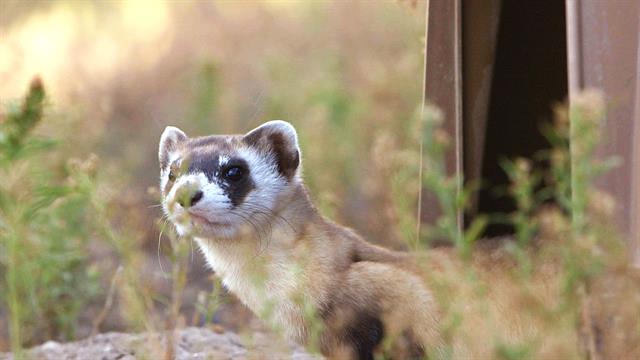Conservationists have been trying to save North America’s only native ferret for more than four decades. Twice it has been declared extinct. Now, scientists have come up with a pioneering plan to protect the black-footed ferret by protecting its prey against disease.
It is the only effort of its kind to save an endangered species. Black-footed ferrets now number several hundred remaining in the wild, with another 300 ferrets in captivity. To succeed, scientists have two odd tools at their disposal: peanut butter vaccines and drones. (See "Once Thought Extinct, North America's Rarest Mammal May Bounce Back.")
The masked prairie dwellers, which weigh just under three pounds (1.4 kilograms), survive almost entirely on a diet of prairie dogs—usually three a week. They also live in prairie dog burrows. Prairie dogs—and ferrets—are susceptible to the sylvatic plague, a flea-borne illness so devastating it can quickly wipe out whole prairie dog colonies.
When colonies die off, ferrets lose not only their food, but also their home. In other words, saving the prairie dogs from the plague saves ferrets.
“Plague is the largest obstacle to ferret recovery today,” says Ryan Moehring, a U.S. Fish and Wildlife Service spokesperson.
Ferrets can be vaccinated individually against the plague by injection, but injecting large populations of prairie dogs is impossible. So a team of scientists at the University of Wisconsin spent 15 years developing an oral vaccine for prairie dogs, says Tonie Rocke, a research epizootiologist at the U.S. Geological Survey's National Wildlife Health Center in Madison, Wisconsin, who led the effort.
In tests, the vaccine was inserted into pellet-size treats baited with blueberries, sweet potatoes, and peanut butter. “Peanut butter was the overwhelming favorite,” Rocke says.
This week, the fish and wildlife agency plans to test a prototype of a treat dispenser on an all-terrain vehicle and spread the vaccine treats in prairie dog colonies in the UL Bend National Wildlife Refuge in northeastern Montana, where plague has wiped out some 2,000 of 3,000 acres (810 of 1,200 hectares) of prairie dog populations.
Shaky Success
The black-footed ferret descends from the European polecat and migrated across the Bering land bridge and settled in the vast North American prairie, where they found an endless supply of prairie dogs. (Read "The Emptied Prairie" in National Geographic magazine.)
When European settlers homesteaded the Great Plains, they eradicated the prairie dog. The settlers also brought the plague with them. By the 1950s, the ferret had disappeared from the prairie and was believed to be extinct. In 1964, a ferret population was found in South Dakota, but by 1979, all had died. The ferret was again declared extinct.
Then, in 1981, after a ferret was found in Wyoming, scientists launched a captive-breeding program, which has led in the years since to the release new ferret populations across the Great Plains states and Arizona, New Mexico, and Utah.
Those new populations are at risk as long as the prairie dog is vulnerable to plague. (Also see "Prairie Dogs Are Serial Killers That Murder Their Competition.")
For years, scientists tried to protect prairie dogs by spraying their burrows with flea powder. But the chore was labor-intensive—every burrow had to be sprayed, and over time, the fleas developed a resistance to the powder.
After developing the oral vaccine, more obstacles remained: getting the prairie dogs to eat the vaccine and distributing it over large areas.
In experiments, researchers put peanut butter vaccines out in the morning, when prairie dogs are most active. The treats were found within 20 minutes and all disappeared the first day. The treats also contain blue dye that stains the prairie dogs’ whiskers and feces, confirming that they’ve eaten the vaccine.
Prairie Staple
The distribution plan is still a work in progress. The government agency is working to develop equipment that would attach to a drone, or unmanned aerial vehicle, and dispense the treats at a rate of 50 per acre.
Prairie dogs are considered a “keystone” species, meaning they play a disproportionate role in survival of their habitat. Aside from ferrets, hawks, burrowing owls, and other carnivores are dependent on prairie dogs for survival.
“If prairie dogs die out, all those other species go away as well,” Rocke says. “We are targeting prairie dogs and ferrets. But [it's] an attempt to preserve the grassland ecosystem.


No comments:
Post a Comment